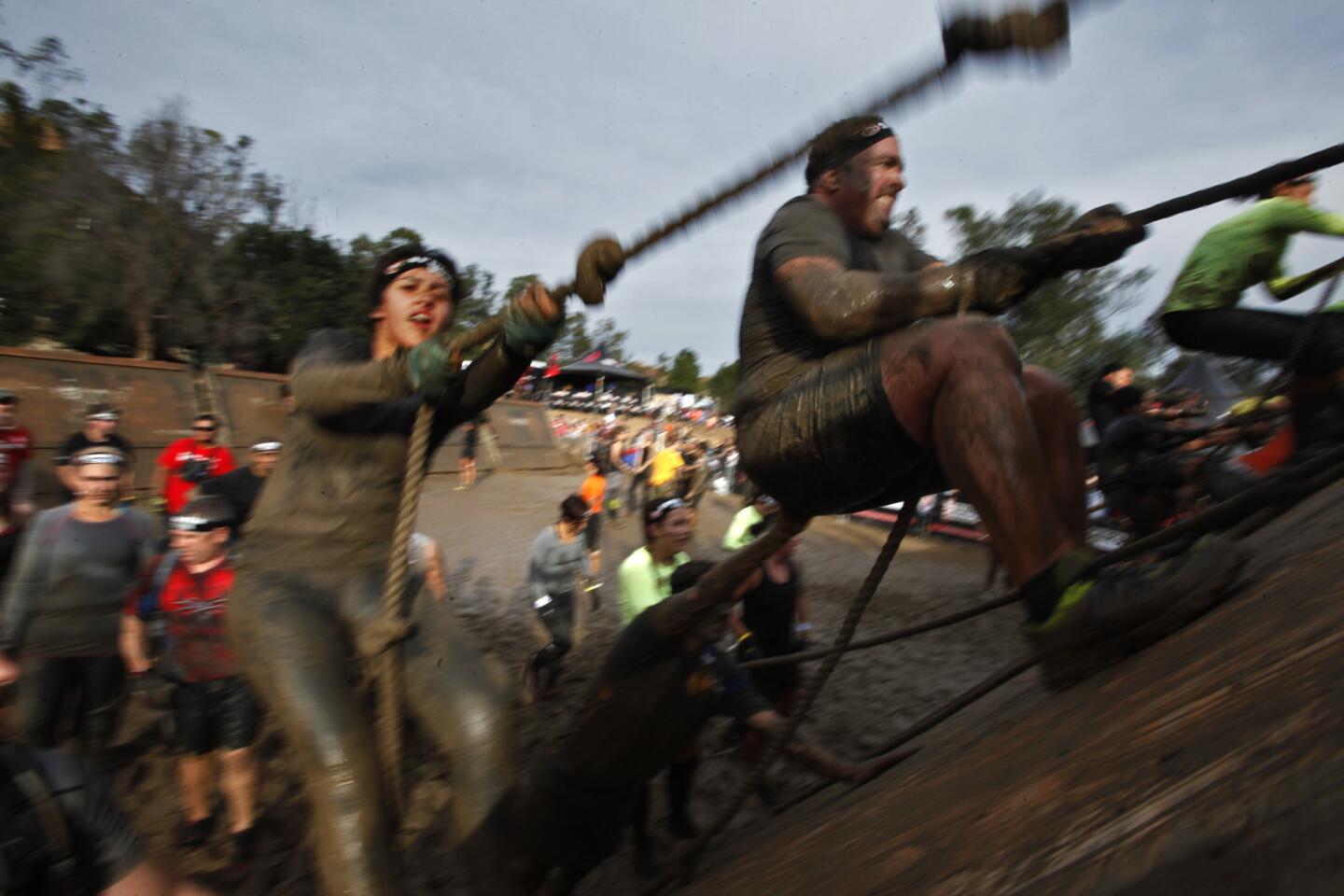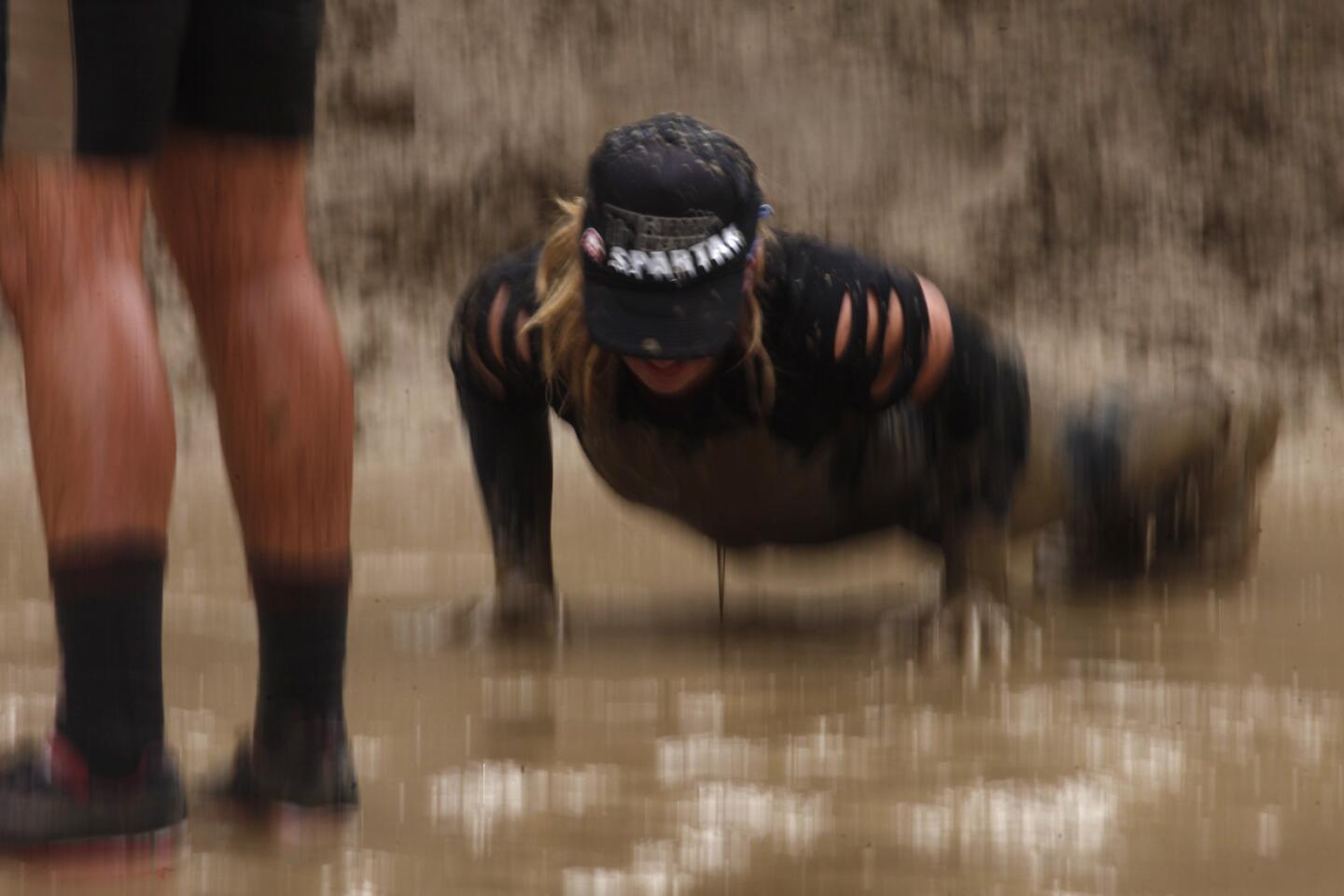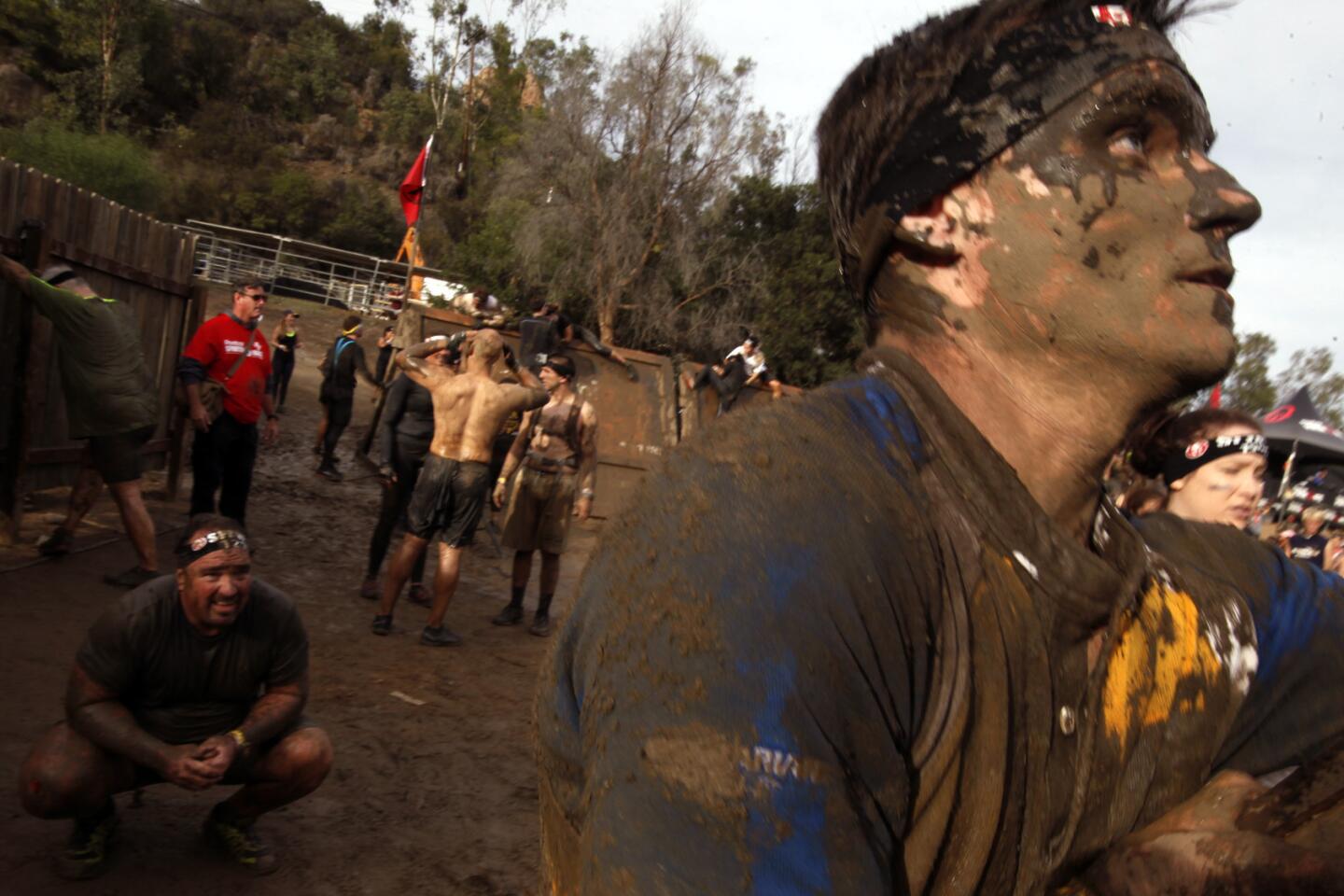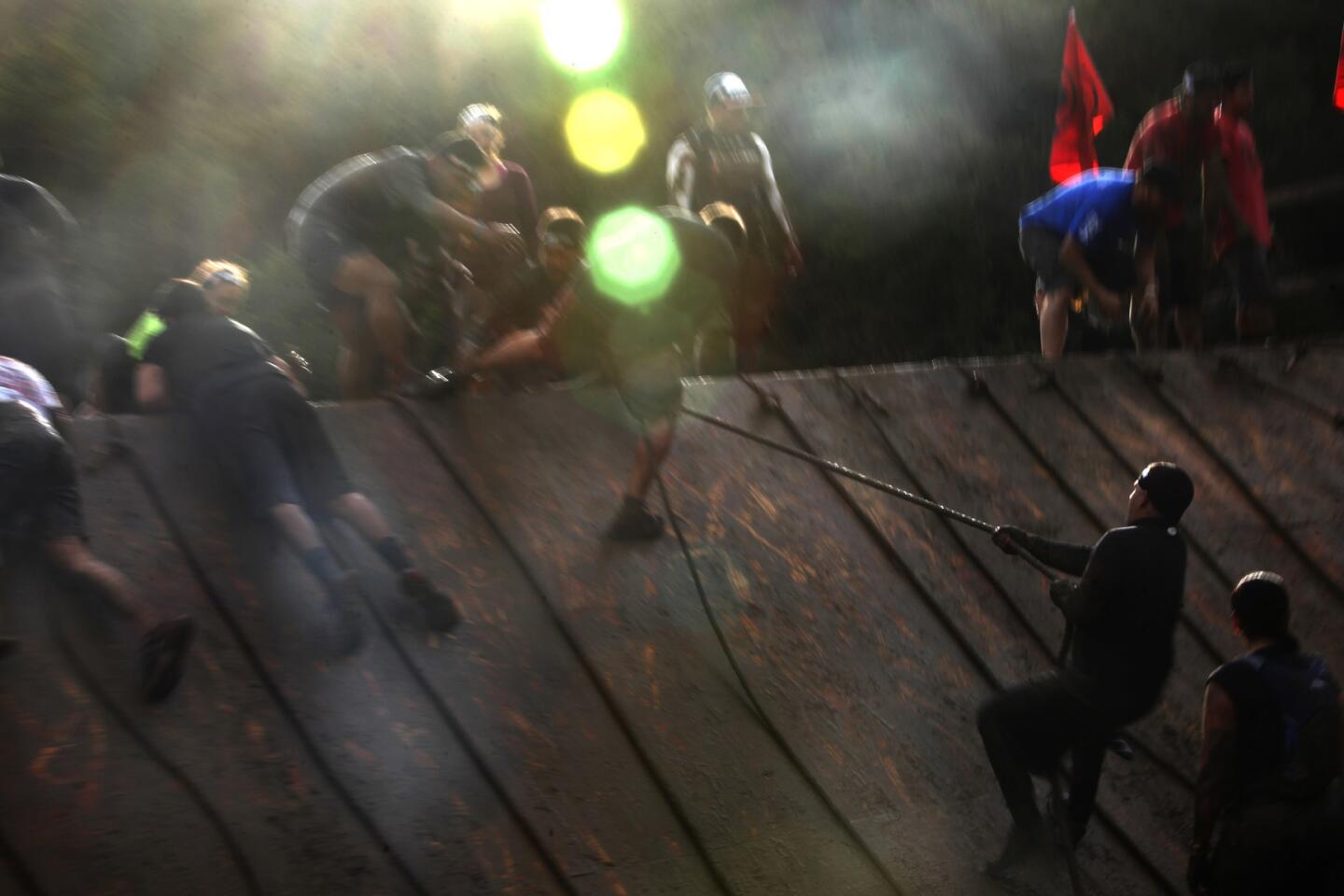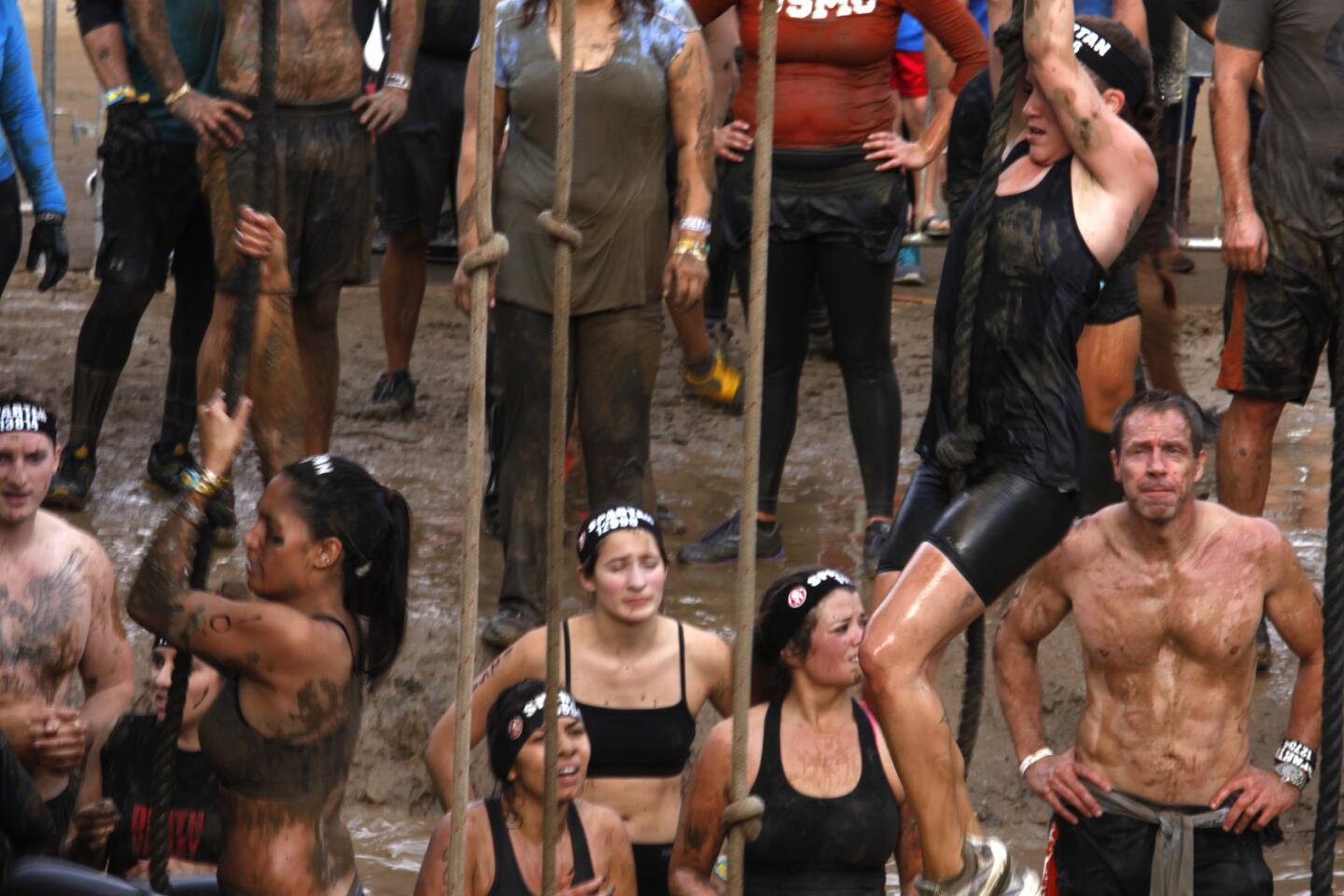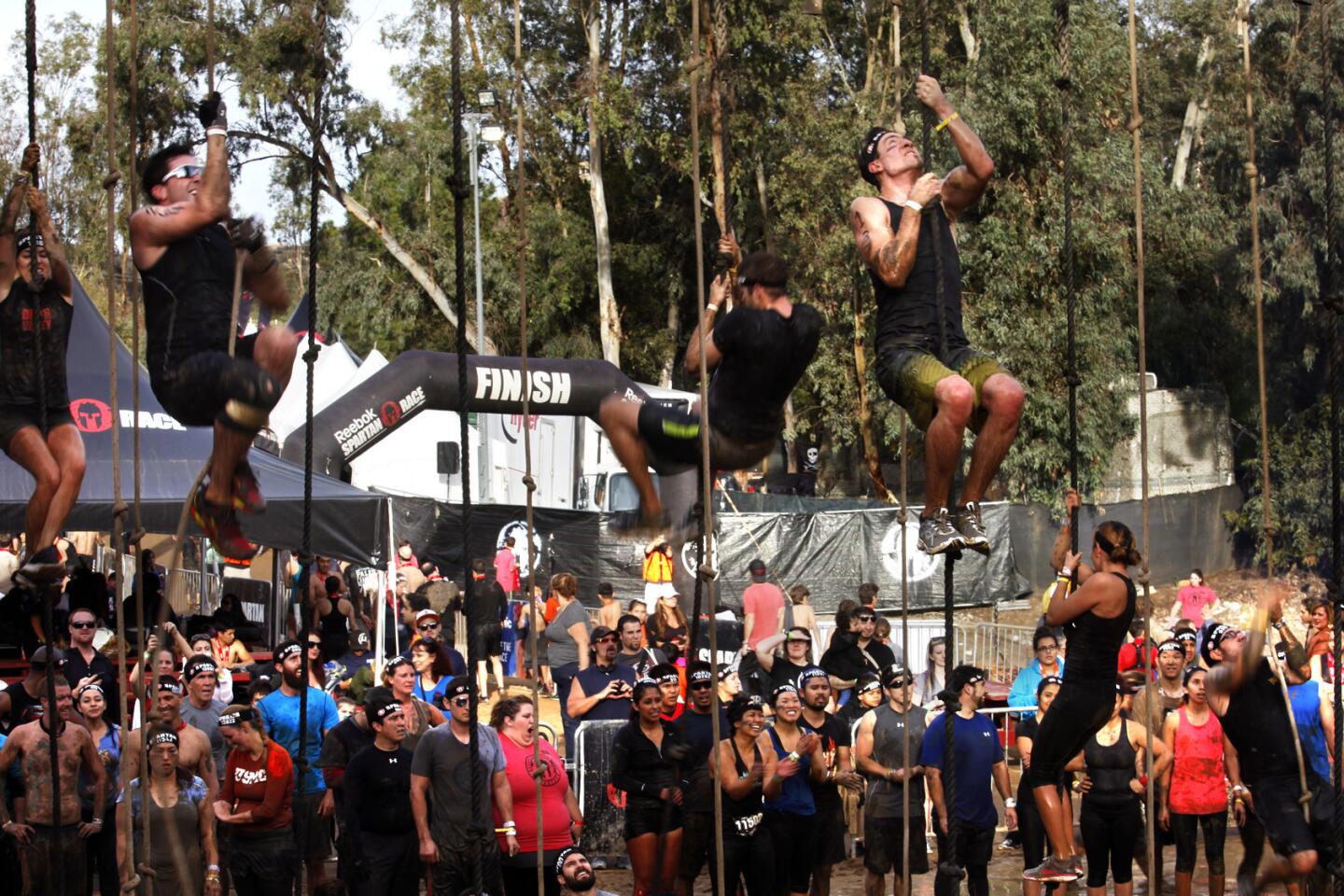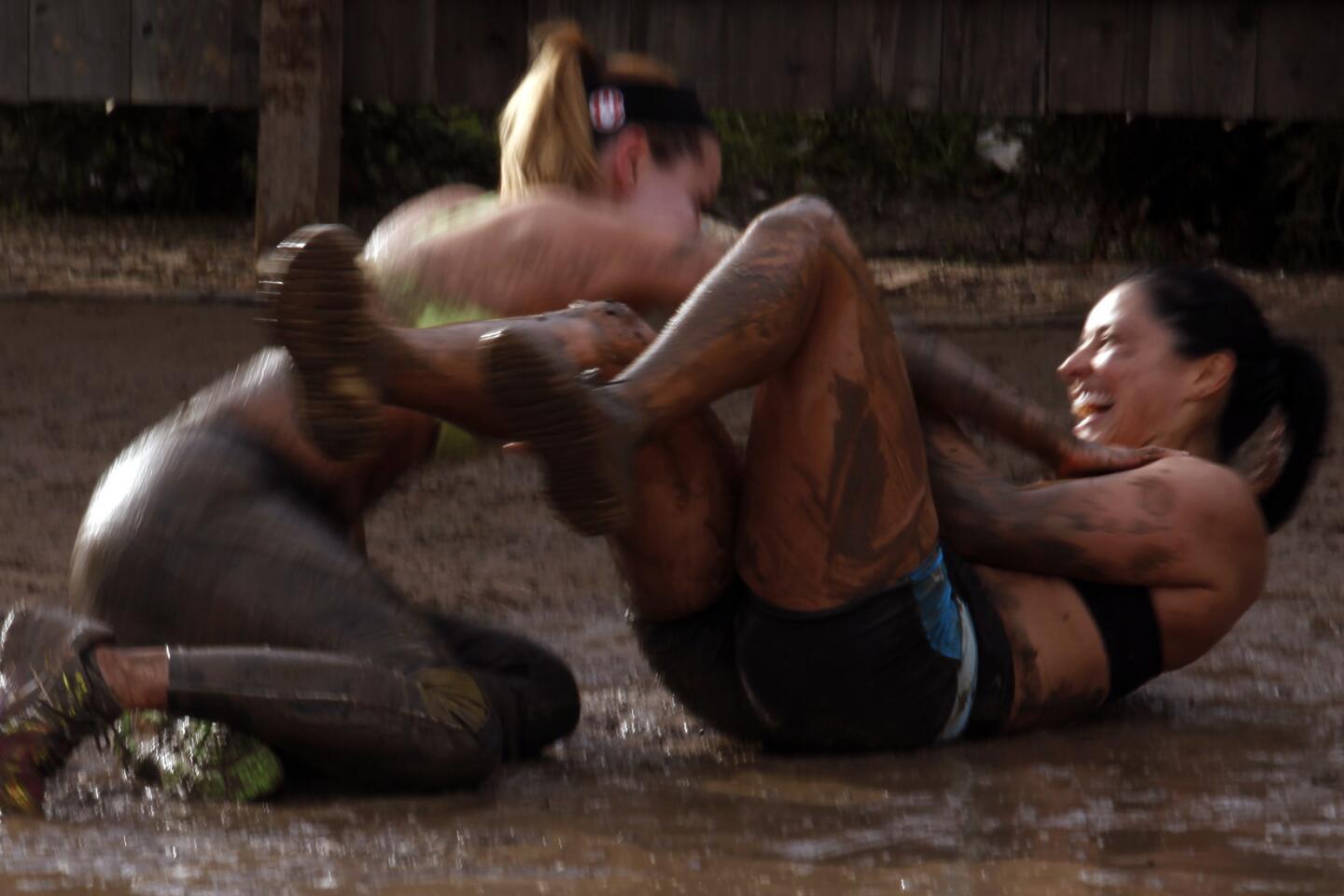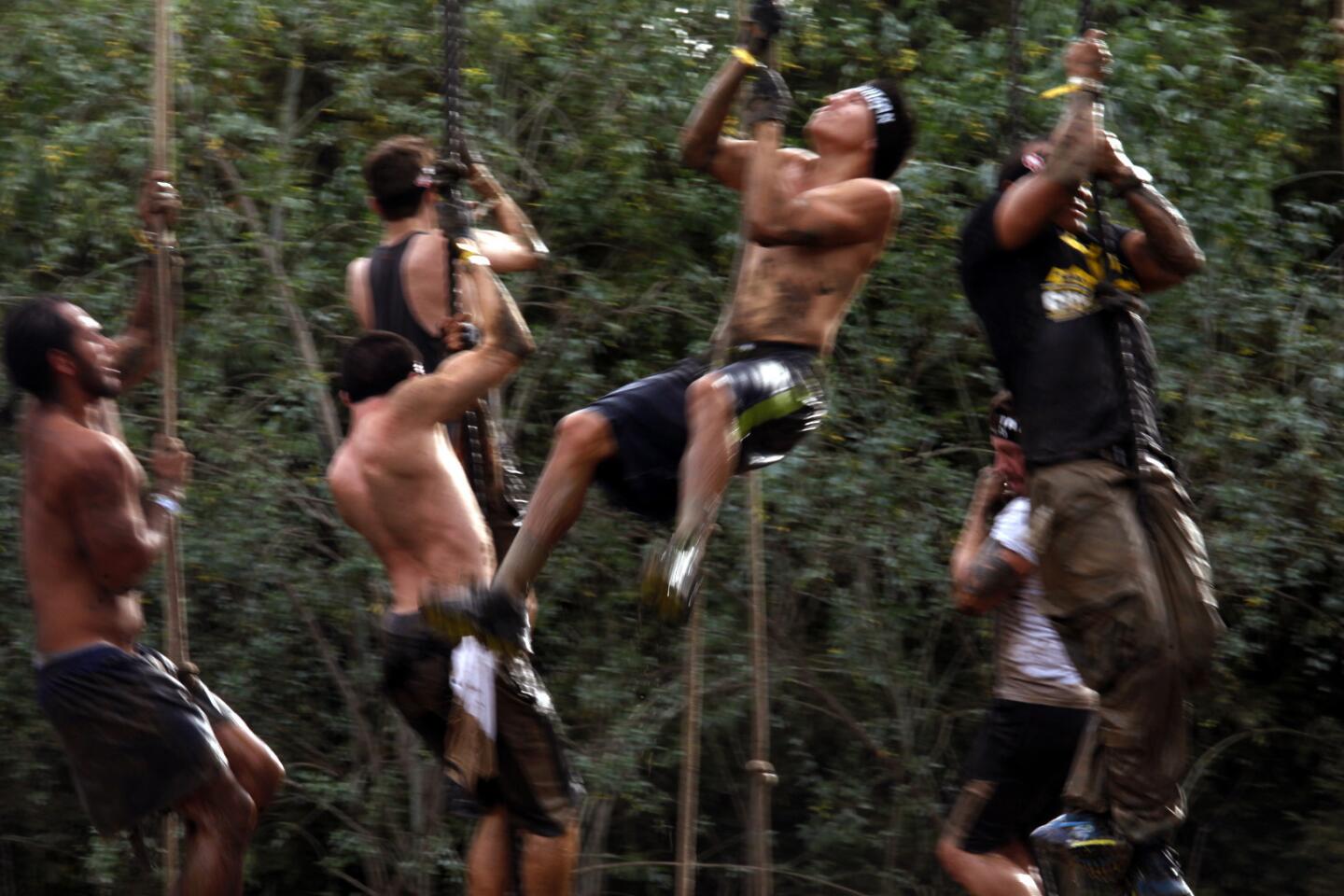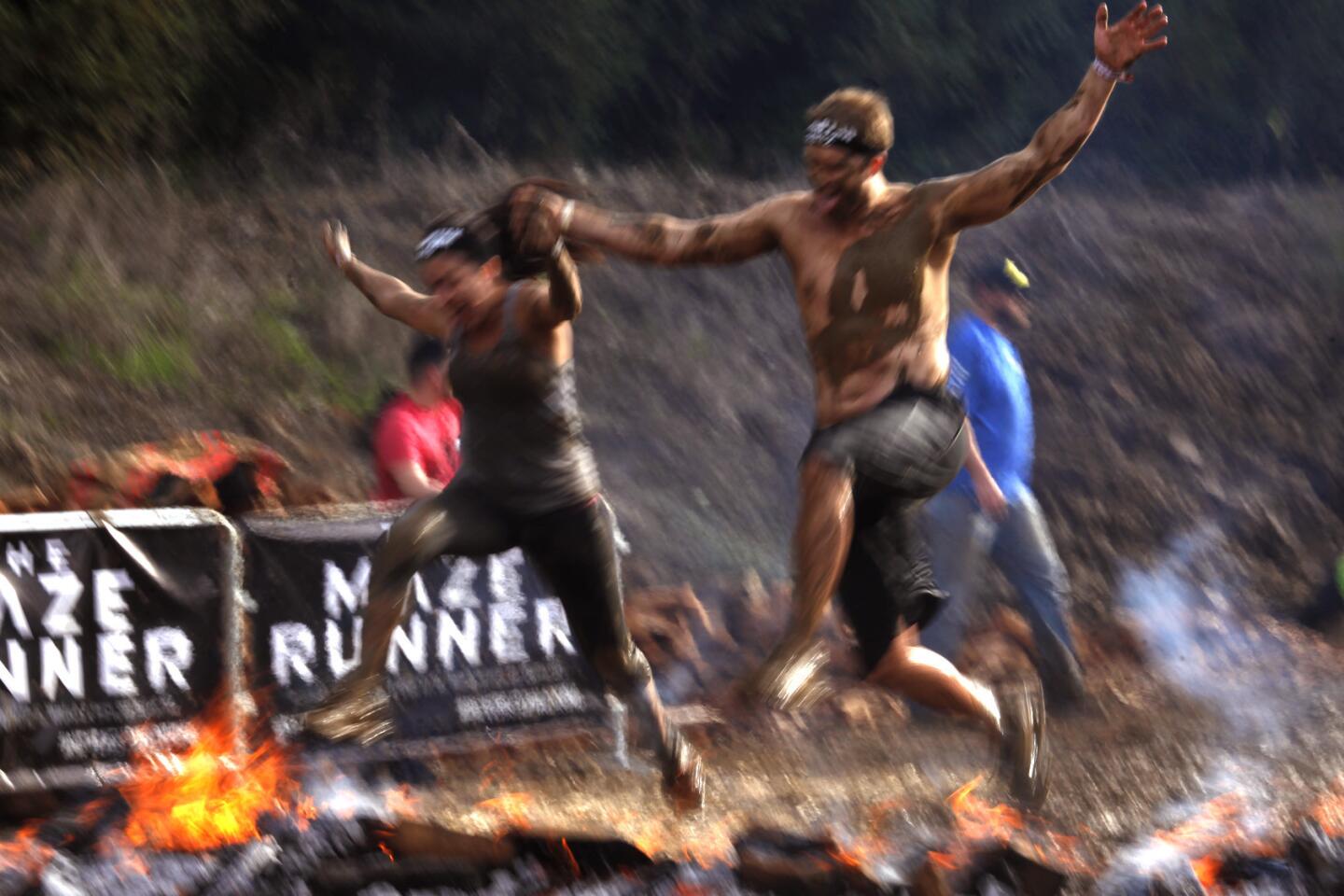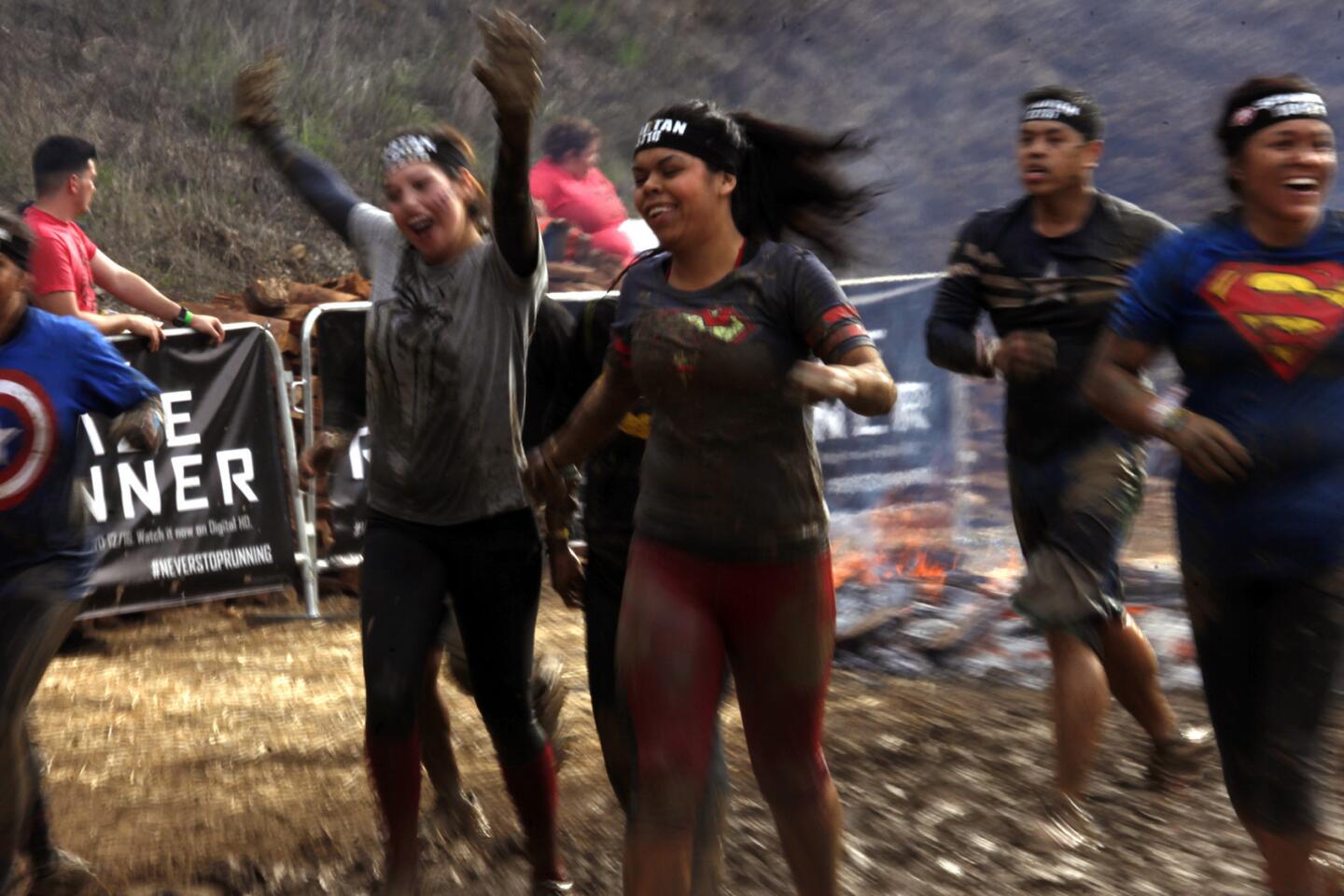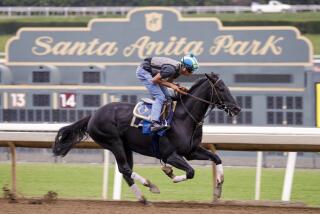Mud runners risk limb and even life to satisfy extreme-sports passion
The sun had just peeked up over the Santa Monica Mountains when the school buses arrived at Calamigos Ranch in Malibu and deposited the racers at their first obstacle of the day.
Some races start with a popgun. Some start with a flag. The Spartan Race started with a waiver. You could die, it said. Even as a spectator.
Everybody signed anyway. And with that, they were off to the mud.
For two days over a recent weekend, the sprawling ranch, tucked in the hills about five miles inland from the Pacific Ocean, was alive with more than 5,200 men and women trudging up inclines and through muck. Many of the women wore leggings and sports bras. Some of the men didn’t bother with shirts and referred to one another as “bro.”
Speakers blasted an up-tempo playlist — a lot of Pitbull.
Each heat of the race began with the chant of a battle cry: “Haaa-ooo. Haaa-ooo. Haaa-ooo.” Spirits were high. But by the time many of the runners reached the top of the hills, about the halfway point, they were already tired.
Along the course, they scaled walls, navigated a cargo net, traversed a monkey bar-like maze of metal poles, ducked under barriers, crawled on their chests and pounded out a set of burpees. Blood trickled down backs. Mud coated faces. By the end, some didn’t look well.
One woman got to within steps of the finish line only to squirm and shrink back. She still had to leap over a roaring fire. Nearby, a man clung to a slick rope above a muddy pit of water. He was nearly all the way up, but his arms couldn’t take him any farther, so he hung on limply and scowled. Every so often determination gripped his face and he made a lunge at the top. Over and over he tried, but couldn’t make it.
The scene looked less like a race and more like punishment.
The course was designed, Gustavo Banderas of Whittier said, “to test your weaknesses.”
To prepare, Will Varguez of Lynwood had exercised with a weight vest and an altitude mask. He thought he was ready.
He thought wrong. “My training didn’t compare,” Varguez said. “Now I know.”
The winner, Jose Aguirre, finished the three-mile course with a time of 42 minutes 6 seconds.
A mud run such as the Spartan Race is part foot race, part CrossFit workout and part left to an organizer’s imagination. The obstacles change often. In Malibu, some were kept confidential, so racers wouldn’t know what to expect.
Other mud runs have included tests of strength, like pulling blocks of stone through sand; tests of mental fortitude, by running through a web of 10,000-volt live wires; and whatever is tested by chopping a big bushel of onions.
As mud running approaches the end of its fifth year, one part of a race’s formula is mostly unchanged: Torture your customers. Then hope they come back for more.
Tough Mudder, the organizing body that popularized mud runs five years ago, says 700,000 people participated in its events last year, and hundreds of thousands more ran in competing mud runs, such as Spartan Race. But reformers wonder if those numbers can last.
Sam Mansfield, co-founder of United States Obstacle Course Racing, an upstart sanctioning body, says that by 2012, “everybody and their mother” operated a mud run. The next year, he said, the bubble burst and participation numbers dived.
Mansfield and other reformers believe the industry should focus more on the serious athletes who will return for multiple races.
Tough Mudder would prefer its events stay noncompetitive, but Spartan has pushed in an opposite direction and this year signed a multiyear agreement with NBC Sports Network. The terms of the deal were not disclosed, but the network televised six Spartan Races in 2014.
Spartan also helped organize an international body that will push for Olympic status.
Meanwhile, reformers are pushing for industrywide safety standards. In the past, participants have sued after sustaining serious injuries. In one instance, a hospital in Pennsylvania was flooded with so many mud runners that the emergency room operated under mass-casualty procedures, as it would after a terrorist attack. They even used chemical showers for all the mud.
“I thought it was some tragic mistake, something had gone terribly wrong and people were getting electrocuted,” said Marna Greenberg, one of the attending physicians.
Current safety conditions, such as they are, “scares the willies out of insurance carriers,” said Mike Price, the president of ESIX, a sports insurance underwriter that recently partnered with Mansfield and USOCR.
Will Dean, Tough Mudder’s founder, says his events continue to grow. Dean said that 95% of participants indicate they’ll do another event and nearly 25% sign up to go again within a week.
Racers face danger over many of the courses and injuries are common, though statistics are not available.
However, that doesn’t dissuade many competitors. “You know that you may get hurt,” Banderas said. “To me that’s part of the appeal.”
At the race in Malibu, motivation for participating was as varied as the obstacles.
Tasha Bartuzik, 58, said she enjoyed the feeling of accomplishment. The Malibu resident said she had trained for a year for the race.
There is also a social aspect to the competition. Many racers like that they can share intense photos with their friends online. At a makeshift village near the finish line, vendors hawked body camera rentals. An army of photographers, complete with high-powered lights, positioned themselves at obstacles to shoot race photos for Spartan’s website.
Chris Gurich of Malibu wore a GoPro camera strapped around his head. He said he planned to upload the video to YouTube and Facebook, add music and, he said with a laugh, “edit the obstacles that I missed.”
Most of the racers had trained for months or more, pushing tires, running hills, doing CrossFit. And that was for, by Spartan standards, an easy race.
Almost anyone could do it, Michael Gatale of Malibu said. Though you’d probably have to walk a lot, and maybe skip some of the obstacles, he added.
“You’d be dead,” Gatale told a 20-something observer. “But you could do it. I think.”
More to Read
Get our high school sports newsletter
Prep Rally is devoted to the SoCal high school sports experience, bringing you scores, stories and a behind-the-scenes look at what makes prep sports so popular.
You may occasionally receive promotional content from the Los Angeles Times.
